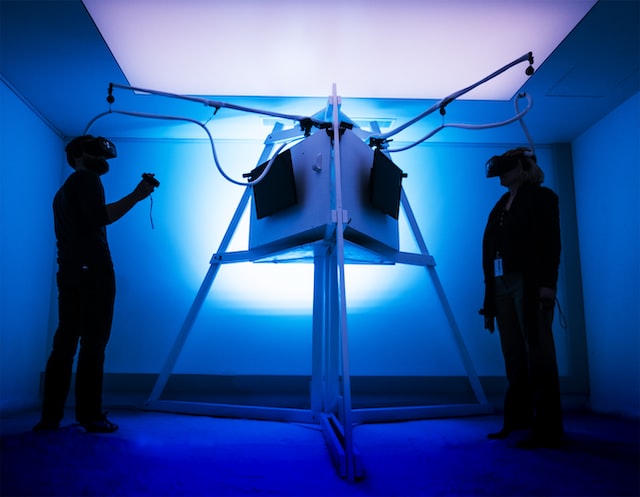In the business world, virtual reality (VR) has become an invaluable tool for business success. From customer engagement to employee training and product development, VR offers business owners a unique opportunity to increase their reach and maximize efficiency. With the right business strategy and creative application of VR technology, entrepreneurs can start their own business with virtual reality.
Introduction: What is Virtual Reality (VR) and How It Can Help Businesses
Virtual Reality (VR) is a type of computer-generated 3D environment that allows people to explore and interact with simulated worlds in an immersive way. By utilizing VR technology, business owners can create interactive experiences for customers and employees that capture their attention and make it easier to digest information. This includes virtual product demonstrations or employee trainings, which can help reduce overhead costs while boosting customer engagement. VR also enables business owners to conduct market research more efficiently by giving them the ability to understand consumer behavior through data collection and analysis. Ultimately, VR offers business owners an unparalleled opportunity to reach new heights of success.
Benefits of Starting a VR Business
Starting a business with virtual reality has numerous benefits, some of which include:
– Increased customer engagement and loyalty: VR technology can help business owners gain trust from their customers by providing an interactive experience that engages them more deeply than traditional methods. This helps business owners build relationships with their customers, which leads to increased loyalty over time.
– Improved employee training: VR business applications allow employers to create immersive training simulations that provide a safe environment for employees to practice without risking valuable resources or putting themselves in danger. These types of simulations make it easier for business owners to train new staff quickly and cost-effectively.
– Cost savings: Launching a business with virtual reality technology can reduce overhead costs associated with physical products or live demonstrations. Additionally, using VR business applications eliminates the need for costly business trips, which further reduces expenses.
Overall, business owners who leverage VR technology can enjoy a wide range of benefits that will help them maximize efficiency and optimize their business operations.
What You Need to Know Before Launching and Owning a VR Business
Before launching a business with virtual reality, business owners should be aware of the following:
– Understand the market: It’s important for business owners to understand the needs of their target audience before investing in VR technology. Educate yourself on current trends and customer behavior in order to create an experience that is tailored to your customers’ needs and interests.
– Familiarize yourself with the technology: To own a VR business successfully, Make sure you have a good grasp on the technology behind VR business applications. Understand the different components and how they work together in order to create an effective experience that will engage your customers.
– Plan ahead: Business owners should plan ahead when launching a business with virtual reality. This includes budgeting for upfront costs, researching potential business partners, and understanding the risks associated with investing in VR technology.
Being knowledgeable about these aspects of launching a business with virtual reality is essential for business owners who want to make sure their investments pay off.
Understanding the Technology Behind VR

To fully understand how to start a business with virtual reality, business owners need to have an understanding of the different components of VR technology and how they work together. The technology behind VR business applications is comprised of two main parts: the hardware and the software.
The hardware includes devices such as headsets, controllers, and tracking systems that allow users to interact with virtual environments. The headset allows business owners to create an immersive experience for their customers by displaying a stereoscopic image in front of them that simulates 3D space. Controllers enable users to physically interact with the virtual environment and respond naturally to stimuli within it. And finally, tracking systems use sensors and cameras to track a user’s movements within a VR business application so they can move freely without being bound by physical limitations.
Software is also essential for VR business applications, as it enables business owners to create interactive experiences that bring their vision to life. This includes creating 3D models, environments, and animations that capture a user’s attention and draw them into the virtual world.
Understanding the technology behind VR business applications is essential for business owners who want to create meaningful experiences for their customers. By familiarizing themselves with the hardware and software components of VR technology, business owners can ensure they are investing in the right components to create an effective experience.
Overall, starting a business with virtual reality offers business owners many advantages over traditional methods. From improved customer relations to cost savings, business owners can leverage the power of VR technology to take their business to new heights. However, it’s important for business owners to understand the different components of VR technology before launching their business for maximum success. With the right knowledge and preparation, business owners can start their business with virtual reality and maximize efficiency and optimize their business operations.
Creating an Engaging Environment with VR
Business owners who want to own a VR business need to create an engaging environment for their customers. This is essential for business owners to ensure that their investments in VR technology are worthwhile and that they can capture their customer’s attention.
Creating an engaging environment starts with understanding the needs of your target audience and designing a virtual experience tailored to them. Consider how your business can leverage the power of VR technology to provide unique experiences, such as interactive tutorials or tour simulations, to give customers a more comprehensive understanding of your business offerings.
In addition, business owners should be sure to include elements such as sound effects and visuals that capture customers’ attention and draw them into the experience. By creating an immersive and engaging environment, business owners can ensure that their customers are captivated and more likely to purchase their products or services.
Overall, creating an engaging environment with VR is essential for business owners who want to start a business with virtual reality. By understanding their target audience’s needs and designing experiences tailored to them, business owners can make sure they are delivering an experience that will capture customers’ attention and drive business growth. With the right planning and execution, business owners can use VR technology to create immersive experiences that draw in customers and help them succeed.
Strategies for Promoting and Growing Your VR Business
Once business owners have set up their business with virtual reality, they need to find ways to promote and grow their business. Promoting a business with VR technology can be challenging, as business owners must adhere to certain standards such as avoiding inappropriate content or misrepresenting products or services.
Businesses should begin by leveraging existing social networks for promotion since these are already established channels for customers and potential customers alike. Consider creating promotional videos showcasing the unique aspects of your business’s virtual experiences and share them on platforms like YouTube, Facebook, Instagram, and Twitter.
In addition, business owners should explore targeted advertising options that use user data to narrow in on specific groups of users who may be interested in the business’s offerings. This can help business owners ensure that their ads are reaching the right audience and maximize the return on their investment.
Overall, business owners need to be strategic when promoting and growing their business with virtual reality. By leveraging existing networks and targeted advertising strategies, business owners can ensure they reach the right customers and maximize the success of their business. With the right strategies in place, business owners can use VR technology to promote and grow their business.
Conclusion: Reap the Rewards of Starting a VR Business
Starting a business with virtual reality technology can yield powerful rewards for business owners. VR technology offers business owners the opportunity to create immersive and engaging experiences that draw in customers and maximize business growth. The key is for business owners to understand their target audience’s needs, design experiences tailored to them, and leverage existing networks and targeted advertising strategies for promotion.
By following these steps, business owners can reap the rewards of starting a business with virtual reality technology. With the right planning and execution, business owners can use VR technology to create unique experiences that capture customers’ attention and drive business success.

